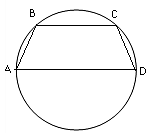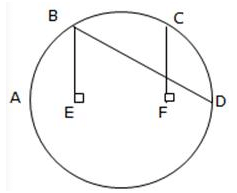CAT Exam > CAT Questions > Find the sum of areas enclosed between arc A...
Start Learning for Free
Find the sum of areas enclosed between arc AB and line AB, between arc BC and line BC and between arc CD and line CD where ABCD is isosceles trapezium inscribed in a circle of radius 20 cm so that the non-parallel sides are 20 cm each and AD is the diameter of the circle?

- a)200 π - 320 √3
- b)200 π - 300 √3
- c)200 π - 350 √3
- d)None of these
Correct answer is option 'B'. Can you explain this answer?
| FREE This question is part of | Download PDF Attempt this Test |
Most Upvoted Answer
Find the sum of areas enclosed between arc AB and line AB, between ar...

Since AD is the diameter of the circle, we know that ∠ABD = 90°. In ΔABD, since AB = ½ AD, we can conclude that ∠D = 30° and ∠A = 60°.
Drop BE ^ AD and CF ^ AD. Since ΔBEA is a 30° - 60° - 90° triangle,
BE = 10√3 cm and AE = 10 cm.
Since ABCD is an isosceles trapezium, we get AE = FD = 10 cm and EF = BC = 20 cm.
Thus the area of trapezium ABCD = ½ × (20 + 40) × 10√3 = 300√3 cm2
Sum of areas enclosed between arc AB and line AB, between arc BC and line CD and arc CD
=Area of semi circle - Area of trapezium ABCD
=½ π (20)2 - 300√3
=200 π - 300 √3
Attention CAT Students!
To make sure you are not studying endlessly, EduRev has designed CAT study material, with Structured Courses, Videos, & Test Series. Plus get personalized analysis, doubt solving and improvement plans to achieve a great score in CAT.

|
Explore Courses for CAT exam
|

|
Similar CAT Doubts
Find the sum of areas enclosed between arc AB and line AB, between arc BC and line BC and between arc CD and line CD where ABCD is isosceles trapezium inscribed in a circle of radius 20 cm so that the non-parallel sides are 20 cm each and AD is the diameter of the circle?a)200 π - 320 √3b)200 π - 300 √3c)200 π - 350 √3d)None of theseCorrect answer is option 'B'. Can you explain this answer?
Question Description
Find the sum of areas enclosed between arc AB and line AB, between arc BC and line BC and between arc CD and line CD where ABCD is isosceles trapezium inscribed in a circle of radius 20 cm so that the non-parallel sides are 20 cm each and AD is the diameter of the circle?a)200 π - 320 √3b)200 π - 300 √3c)200 π - 350 √3d)None of theseCorrect answer is option 'B'. Can you explain this answer? for CAT 2024 is part of CAT preparation. The Question and answers have been prepared according to the CAT exam syllabus. Information about Find the sum of areas enclosed between arc AB and line AB, between arc BC and line BC and between arc CD and line CD where ABCD is isosceles trapezium inscribed in a circle of radius 20 cm so that the non-parallel sides are 20 cm each and AD is the diameter of the circle?a)200 π - 320 √3b)200 π - 300 √3c)200 π - 350 √3d)None of theseCorrect answer is option 'B'. Can you explain this answer? covers all topics & solutions for CAT 2024 Exam. Find important definitions, questions, meanings, examples, exercises and tests below for Find the sum of areas enclosed between arc AB and line AB, between arc BC and line BC and between arc CD and line CD where ABCD is isosceles trapezium inscribed in a circle of radius 20 cm so that the non-parallel sides are 20 cm each and AD is the diameter of the circle?a)200 π - 320 √3b)200 π - 300 √3c)200 π - 350 √3d)None of theseCorrect answer is option 'B'. Can you explain this answer?.
Find the sum of areas enclosed between arc AB and line AB, between arc BC and line BC and between arc CD and line CD where ABCD is isosceles trapezium inscribed in a circle of radius 20 cm so that the non-parallel sides are 20 cm each and AD is the diameter of the circle?a)200 π - 320 √3b)200 π - 300 √3c)200 π - 350 √3d)None of theseCorrect answer is option 'B'. Can you explain this answer? for CAT 2024 is part of CAT preparation. The Question and answers have been prepared according to the CAT exam syllabus. Information about Find the sum of areas enclosed between arc AB and line AB, between arc BC and line BC and between arc CD and line CD where ABCD is isosceles trapezium inscribed in a circle of radius 20 cm so that the non-parallel sides are 20 cm each and AD is the diameter of the circle?a)200 π - 320 √3b)200 π - 300 √3c)200 π - 350 √3d)None of theseCorrect answer is option 'B'. Can you explain this answer? covers all topics & solutions for CAT 2024 Exam. Find important definitions, questions, meanings, examples, exercises and tests below for Find the sum of areas enclosed between arc AB and line AB, between arc BC and line BC and between arc CD and line CD where ABCD is isosceles trapezium inscribed in a circle of radius 20 cm so that the non-parallel sides are 20 cm each and AD is the diameter of the circle?a)200 π - 320 √3b)200 π - 300 √3c)200 π - 350 √3d)None of theseCorrect answer is option 'B'. Can you explain this answer?.
Solutions for Find the sum of areas enclosed between arc AB and line AB, between arc BC and line BC and between arc CD and line CD where ABCD is isosceles trapezium inscribed in a circle of radius 20 cm so that the non-parallel sides are 20 cm each and AD is the diameter of the circle?a)200 π - 320 √3b)200 π - 300 √3c)200 π - 350 √3d)None of theseCorrect answer is option 'B'. Can you explain this answer? in English & in Hindi are available as part of our courses for CAT.
Download more important topics, notes, lectures and mock test series for CAT Exam by signing up for free.
Here you can find the meaning of Find the sum of areas enclosed between arc AB and line AB, between arc BC and line BC and between arc CD and line CD where ABCD is isosceles trapezium inscribed in a circle of radius 20 cm so that the non-parallel sides are 20 cm each and AD is the diameter of the circle?a)200 π - 320 √3b)200 π - 300 √3c)200 π - 350 √3d)None of theseCorrect answer is option 'B'. Can you explain this answer? defined & explained in the simplest way possible. Besides giving the explanation of
Find the sum of areas enclosed between arc AB and line AB, between arc BC and line BC and between arc CD and line CD where ABCD is isosceles trapezium inscribed in a circle of radius 20 cm so that the non-parallel sides are 20 cm each and AD is the diameter of the circle?a)200 π - 320 √3b)200 π - 300 √3c)200 π - 350 √3d)None of theseCorrect answer is option 'B'. Can you explain this answer?, a detailed solution for Find the sum of areas enclosed between arc AB and line AB, between arc BC and line BC and between arc CD and line CD where ABCD is isosceles trapezium inscribed in a circle of radius 20 cm so that the non-parallel sides are 20 cm each and AD is the diameter of the circle?a)200 π - 320 √3b)200 π - 300 √3c)200 π - 350 √3d)None of theseCorrect answer is option 'B'. Can you explain this answer? has been provided alongside types of Find the sum of areas enclosed between arc AB and line AB, between arc BC and line BC and between arc CD and line CD where ABCD is isosceles trapezium inscribed in a circle of radius 20 cm so that the non-parallel sides are 20 cm each and AD is the diameter of the circle?a)200 π - 320 √3b)200 π - 300 √3c)200 π - 350 √3d)None of theseCorrect answer is option 'B'. Can you explain this answer? theory, EduRev gives you an
ample number of questions to practice Find the sum of areas enclosed between arc AB and line AB, between arc BC and line BC and between arc CD and line CD where ABCD is isosceles trapezium inscribed in a circle of radius 20 cm so that the non-parallel sides are 20 cm each and AD is the diameter of the circle?a)200 π - 320 √3b)200 π - 300 √3c)200 π - 350 √3d)None of theseCorrect answer is option 'B'. Can you explain this answer? tests, examples and also practice CAT tests.

|
Explore Courses for CAT exam
|

|
Suggested Free Tests
Signup for Free!
Signup to see your scores go up within 7 days! Learn & Practice with 1000+ FREE Notes, Videos & Tests.
























